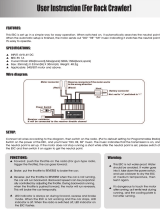
TRAXXAS
•
17
The electronic speed control is factory set and should not require any
adjustments. These instructions are provided for your reference.
Transmitter Adjustments for the electronic speed control
Before attempting to program your ESC, it is important to make
sure your TQ transmitter is properly adjusted (set back to the factory
defaults). Otherwise, you may not get the best performance from your
speed control.
The transmitter should be adjusted as follows:
If the transmitter setting have been adjusted, reset them to the factory
defaults.
1. Turn transmitter off.
2. Hold both MENU and SET.
3. Turn transmitter on.
4. Release MENU and SET. The transmitter LED will blink red.
5. Press SET to clear settings. The LED will turn solid green and the
transmitter is restored to default.
Setup Programming (Calibrating your ESC and transmitter)
Read through all of the following programming steps before you
begin. If you get lost during programming or receive unexpected
results, simply unplug the battery, wait a few seconds, plug the battery
back in, and start over.
1. Disconnect each of the motor wires between the ESC and the
motor. This is a precaution to prevent runaway when the speed
control is turned on before it is programmed.
2. Connect a fully charged battery pack to the ESC.
3. Turn on the transmitter (with the throttle at neutral).
4. Press and hold the EZ-Set button (A). The LED
will rst turn green and then red. Release the
EZ-Set button.
5. When the LED blinks RED ONCE.
Pull the throttle trigger to the
full throttle position and hold it
there (B).
6. When the LED blinks RED TWICE.
Push the throttle trigger to the
full reverse and hold it there (C).
7. When the LED starts ashing GREEN,
programming is complete. After the throttle is
returned to neutral, the LED will then shine solid
green or red (depending on the
Low-Voltage
Detection
setting, see note below) indicating the
VXL-3m is on and at neutral (D).
ESC Operation
Note: In steps 1-7 below, Low-Voltage Detection is turned off (factory
default) and the LED shines RED. If Low-Voltage Detection is on, the
LED will shine GREEN instead of RED in steps 1-7 below.
To operate the speed control and test the programming, place the
vehicle on a stable block or stand so all of the driven wheels are off the
ground. Reconnect the motor wires. Always make sure that objects and
ngers are clear of the wheels.
1. With the transmitter on, press the EZ-Set button for ½ second,
until the LED shines GREEN, then immediately release the button.
This turns on the ESC. If you press and release too quickly, you
may hear the steering servos jump but the LED may not stay on.
2. Apply forward throttle. The LED will turn off until full throttle
power is reached. At full throttle, the led will shine RED.
3. Move the trigger forward to apply the brakes. Note that braking
control is fully proportional. The LED will turn off until full
braking power is reached. At full brakes, the LED will shine RED.
4. Return the throttle trigger to neutral. The LED will shine RED.
5. Move the throttle trigger forward again to engage reverse
(Prole #1). The LED will turn off. Once full reverse power is
reached, the LED will shine RED.
6. To stop, return the throttle trigger to neutral.
7. To turn the ESC off, press the EZ-Set button until the RED LED
turns off.
VXL-3m Thermal Shutdown Protection
The
VXL-3m
is also equipped with thermal shutdown protection. If the
operating temperature exceeds safe limits, the ESC will reduce power
to 50% and the LED will ash red. Additional heating will cause the
speed control to shut down completely until it reaches a safe operating
temperature. Traxxas encourages you to stop driving as soon as the
thermal overload protection is activated.
ADJUSTING THE ELECTRONIC SPEED CONTROL
A
Green then Red
D
Solid
Once Red
B
Twice Red
C
VXL-3m LED codes
Solid Green: VXL-3m power on
light. Low-Voltage Detection is
ON (LiPo setting).
Solid Red: VXL-3m power on light.
Low-Voltage Detection is OFF
(NiCad/NiMH setting).
Fast Blinking Red: Thermal Shutdown
Protection Stage 1. If the motor has
lower than normal power and the VXL-3m
is hot, the VXL-3m has entered Stage 1
Thermal Shutdown Protection to guard
against overheating caused by excessive
current ow. If the motor has no power
and the VXL-3m is very hot, the VXL-3m
has entered Stage 2 Thermal Shutdown
Protection and has automatically shut
down. Let the VXL-3m cool. Make sure
your model is properly geared for the
conditions (see page 24).
Slow Blinking Red (with Low-Voltage
Detection on): The VXL-3m has entered
Low-Voltage Protection. When the
battery voltage begins to reach the
minimum recommended discharge
voltage threshold for LiPo battery packs,
the VXL-3m will limit the power output
to 50% throttle. When the battery
voltage attempts to fall below the
minimum threshold, the VXL-3m will
shut down all motor output. The LED on
the speed control will slowly blink red,
indicating a low-voltage shutdown. The
VXL-3m will stay in this mode until a fully
charged battery is connected.
Alternating; Blinks Red then Green: If
the motor has no power, the VXL-3m
has entered Over Voltage Protection.
If a battery with too high voltage is
used, the VXL-3m will go into a failsafe
mode. Warning: If input voltage exceeds
approximately 20 volts, the ESC may be
damaged. Maximum peak input voltage
limits are 12.6V in LiPo Mode (see page
18) and 18V in NiMH Mode.
Blinking Green: The VXL-3m is indicating
the transmitter Throttle Trim (see page
28) is incorrectly set. Adjust the Throttle
Trim to the middle “0” setting.























